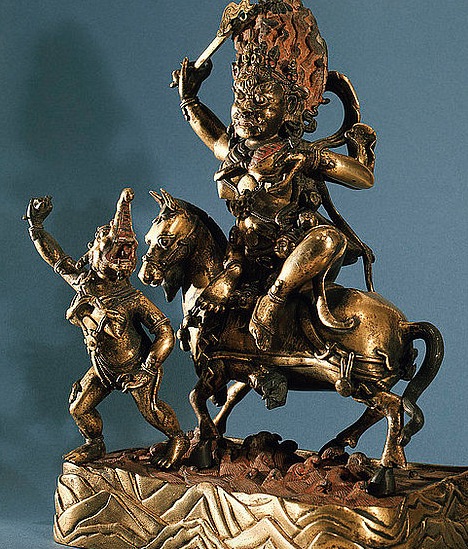Shri Devi, of Hindu origin and known in Tibet as Palden Lhamo, is the wrathful aspect of various female entities. In portable sculpture her most common form is Shrimati (Magzor Gyalmo in Tibetan), a wrathful aspect of Sarasvati with one head, three eyes, two arms, and two legs, who sits sideways on a mule or a kiang, riding across a sea of blood and using the hide of her dead son as a saddle.
18th century, Tibet, Shri Devi, gilt copper alloy, 20,2 cm, The Claude de Marteau Collection Part IV, lot 33, 6th October 2023, Bonhams (Hong Kong).
She wears silk garments, a tiger skin loin cloth, a girdle of snakes, a garland of severed heads, a five-skull crown, and has an umbrella or a canopy above her head (often missing from sculptures). Her flaming hair stands on her head, she chews a corpse, and may wear two different earrings: a snake and a lion. Her attributes are a vajra-tipped staff or club (also missing here) that she brandishes in her right hand and a skull cup filled with magic substances, blood, and a mustard seed, held before her heart.
18th century, Tibet or China?, Magzor Gyalmo, gilt copper alloy with pigment and stone inlay, Himalayan Collection inventory nº Hb/20.D, Museo d’Arte Orientale, Turin (Italy).
Other distinctive features are a crescent moon in her hair and a sun disc on her navel. She usually carries five magic weapons: a tally stick hanging from her belt, a bag of disease, red curses, a pair of dice, fastened at the front of her mount’s harness, a ball of variegated wool, hanging at the back. The harness is actually a long snake knotted and tied around the animal.




































